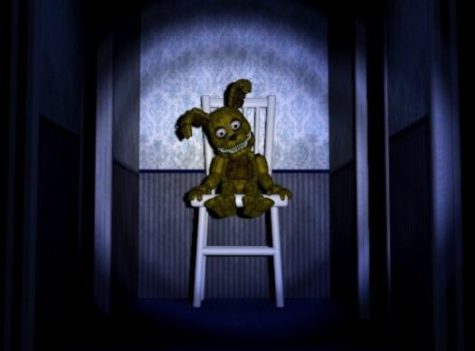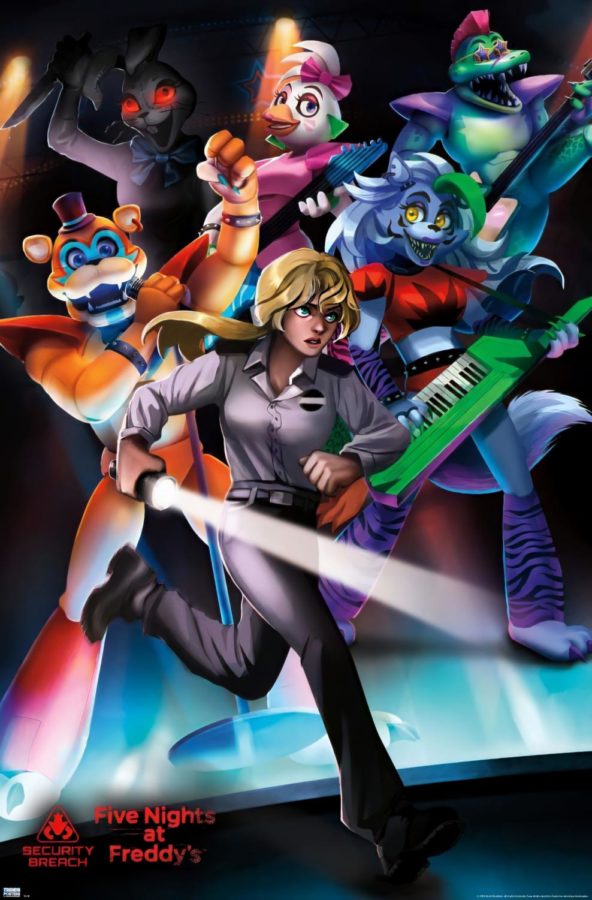Five Nights at Freddy’s: how a horror game captivated an entire generation
February 10, 2022
It’s 2014, you’re ten years old and the bright light of your iPod Touch stings in the pitch black of your bedroom. You wince at the inhuman screeching that’s coming through your lone working earbud while the image of a flashy animatronic embeds itself behind your eyelids.
You have nightmares that night.
And tomorrow, you’ll subject yourself to the same Five Nights at Freddy’s game play in the name of lore/storyline. 12 games and almost 9 years later, you find yourself going back to those same games and playthroughs, not out of spite or boredom, but nostalgia and comfortability.
Introduction
Five Nights at Freddy’s is a point and click survival horror game series created by Scott Cawthon, also known as ScottGames, including 8 main games and 6 spin-offs. The series was then overtaken by Steel Wool Studios in 2018.
- Five Nights at Freddy’s (2014)
- Five Nights at Freddy’s 2 (2014)
- Five Nights at Freddy’s 3 (2015)
- Five Nights at Freddy’s 4 (2015)
- Five Nights at Freddy’s: Sister Location (2016)
- Freddy Fazbear’s Pizzeria Simulator (2017)
- Five Nights at Freddy’s: Help Wanted (2019)
- Five Nights at Freddy’s: Security Breach (2021)
The game’s main storyline, first established in Five Nights at Freddy’s (2014), centers around the player who takes the role of a security guard at Freddy Fazbear’s Pizzeria. The goal is to survive 5 separate night shifts while avoiding the antagonists, the restaurant’s animatronics that have been exhibiting “unpredictable” behavior while slowly uncovering hidden storylines through the introduction of new robots and 8-bit mini games throughout all 5 nights. Which reveals the central plot of all Five Nights at Freddy’s games, the animatronics being possessed by the souls of 5 murdered children within the pizzeria.
The series not only became one of the most popular indie horror games of the 2010s, but lived on to inspire multiple spin-offs, fan created games, analog horror series, and other forms of horror/thriller media to this day. Their present success has been showcased recently in 2021 as their latest game Five Nights at Freddy’s: Security Breach (2021) generated a large amount of online excitement; Some of the biggest names in Gaming YouTube having played and reviewed the game generating millions of views in a short amount of time.
But what makes this franchise so successful?
How did this franchise maintain the attention of an entire generation after all these years?
Theoretical Attributes
In order to understand how Five Nights at Freddy’s remains a staple in horror video games we first have to understand what makes the plot and genre invariably interesting to the viewer to generate a massive online presence over all social media platforms.
Appeal to Horror
Horror, according to the Oxford Dictionary, is an intense feeling of fear, shock, or disgust.
In literary or film, it’s a genre concerned with arousing feelings of horror. While the definition embeds negative tone words, people are drawn to this genre for those specific reasons as emotions like fear and disgust causes a release of adrenaline usually within a controlled environment. Horror structures it’s genre with increased suspense for a consistent level of adrenaline. They push relevancy by referencing universal ideas dealing with death or current social/cultural issues. And points of unrealism, where viewers can realize what they’re watching is fake either using cues of humor or specified music/composition as faux danger releases an excess of adrenaline for one’s “fight or flight mode”, but because there are no real dangers, one experiences pleasure/relief after being scared. The games themselves play upon our childhood fear of inanimate objects coming to life while referencing real establishments like chucky cheese. Ghosts, corpses, dolls, and unrealistic bodily functions also act as universal references to what someone deems generically unsettling throughout the actual games. Using jump scares and creepy imagery to evoke short lived fear, not psychological, which caters to most age ranges and casual horror enjoyers.
Appeal to True Crime
The appeal to true crime has skyrocketed over the past decade as advances in technology make it possible for crime experts to explore historic events while media advancement allows for that information to spread through various digestible sources. True crime itself is a genre in which the author examines a crime and details the actions of the crime including as many facts as possible. Although Five Nights at Freddy’s is a fictional series they set the plot up as a serial killer thriller, enthralling both true crime-esque mystery and fantastical horror.
Each separate game continues and builds upon the main plot, the murder of 5 children within the pizzeria, by including different endings, mini games, and hidden plot points that illustrate the “why” and “how” of the main characters. More importantly following the story between the presented child killer William Afton and his morally ambiguous son Michael Afton. True Crime plays on our inherit curiosity on what drives people to do the “unthinkable”; moreover, leverages our belief in justice. What makes FNAF unique in its storytelling are the different ways they imbed hidden information which furthers the plot/gameplay and adds the interactivity true crime enjoyers want. Hidden texts of information can come as binary codes only obtained by interacting with specific objects within the game. Or finding titles of upcoming characters within the game/sound files themselves. The franchise expanded then to short stories and guidebooks that include key information into revealing the names of characters, possible storylines the games could tackle in the next game installment, and or dates for chronological setups

Physical Attributes
Horror media in general emphasizes immersion using audio and visual cues to clue the viewer into important information, build suspense, showcase settings, and most importantly scare the viewer. Horror video games take advantage of this as the interactive element engages all senses the viewer has into the game’s scene. The Five Night’s at Freddy’s games, specifically the first 4, elevates these attributes due to the game’s mechanics appealing to all age ranges and skill levels. While visual and auditory stimulation psychologically appeals universally through proficient stimuli association
Auditory Stimuli
Sound intensity and general auditory stimulation is a crucial part of all survival/horror video games as sound can be manipulated to evoke strong emotions resulting from built up tension through tonal shifts. Tonal shifts create mood, hearing smooth rhythmic voices creates a sense of safety while harsh jagged voices make the listener uncomfortable. In FNAF 1, you play the game with light buzzing and generators as background noise which is often intercepted with camera clicks and body shifting. This negative to neutral tone of the game is interrupted when you win a round with an upbeat chime and cheer or when you lose with loud screeching. Intersecting these cues during complex situations and or using simple association to create specific moods allows for a dynamic experience of suspenseful highs and lows for the viewer.
“Kids Cheering” audio played after winning a Night in Five Nights at Freddy’s 1 (2014)
Animatronic Jumpscare “XSCREAM” audio played after losing the Night in Five Nights at Freddy’s 1 (2014)
While the gaming series is long and similar in plotlines, they differ in how the developers manipulate sound intensity to create stress. Each game relied on a different mode of sound that correlated with the objective. In FNAF 4, the stress is a product of soft muffled sounds and the difference of volume. The room you play in is silent other than the soft noises made by movement or low breathing, the sound indicator that you are about to be jump scared. The slight difference in volume is now intensified in game because the objective requires you to hyper focus on the low sounds unless met with the negative feedback of fear. FNAF Pizzeria Simulator takes a different approach as you are tasked to be as quiet as possible which directly contrasts your surroundings and actions taken. This auditory conflict heightens stress as noise, the thing you are creating, reflects the negative feedback of being jump scared.
Animatronic “Breathing” audio from Five Nights at Freddy’s 4
Visual Stimuli
The graphic design of video games varies from each genre, open world adventure games usually having brighter colors and lots of movement in the background/setting animation. However, horror games take a different approach to evoke eeriness; horror games manipulating high resolution, high contrast, increased texture, and dramatic lighting to achieve a grim setting.
This is best showcased in FNAF 4 in the minigame “Fun with Plushtrap” where a stationary player flashes an animatronic doll that moves within the pitch black towards you. The hallway you play in is in low lighting, the flickering flashlight and darkened window are the only sources of light. As you play, the game switches between a dark screen and a stationary or close to stationary animatronic in a different location, the dramatic lighting emphasizing its swampy greenish yellow worn down texture. The animatronic having a used and dirty texture and razor teeth in the pitch-black signals’ danger, excluding the ambient unsettling noise and scuffling sounds that add to its fearful nature. But it’s bug-ish eyes and robot features give way to unrealism, leaving the player somewhat disconnect yet not too uncomfortable in their environment.

FNAF Sister Location infuses both auditory conflicts and hyperfocus to volume difference, but the voice lines add extra tone and interaction between the player and character. During specific sequences the actions on the screen and information from other characters contrast the directions explained to you. This contradiction generates visual and auditory conflict, engaging most of the player senses to the tasks at hand. The attachment to these characters based off visuals and their voice caused outside engagement with the game as people inferred their personalities, looks, and possible actions in the next.
And as the years continue, technology, skill level, and financial situations advance resulting in a higher production value of graphic design and animation used. FNAF Security Breach being the most recent game in the series and the first to have open world game play, expanding the players controls abilities within the FNAF realm.
Accessibility
FNAF Sister Location is the first game of the series to add an element of multiple voice lines for characters; as a result, the characters gained human characteristics and personality that generated attachment between player and character. The attachment to these characters based off visuals and voices caused outside engagement with the game as people inferred their personalities, looks, and possible actions in the next game.
Fans have gathered exponentially on social medias like Reddit and Youtube to communicate from around the world their findings and feelings about the latest games to piece together the missing parts of the plot. As the games gained traction, YouTube creators in the gaming community took part in their fandom development by playing through the content and interacting with fans on other platforms as videos which are exhibited to their potentially millions of fans that watch their videos. One of the most notable YouTuber Creator being Markiplier, a gaming YouTuber that grew both his brand and the game series by playing the games in parts from its release. In 2021 he released his game play series of FNAF Security Breach, part one currently having 24 million views.

The way the plot is uncovered breeds interactivity between the creator, Scott Cawthon, the fanbase, and these creators. The chance to debate and confide in large YouTube creators like Game Theory, a YouTube channel dedicated to theorizing and debunking video games, brings an incentive for fans to watch and play the games themselves in order to become a part of the discourse. While the games themselves are affordable compared to other large gaming series. According to the Steam, a website that allows people to buy and play games, the prices are as listed:
Free for FNAF Pizzeria Simulator
$4.99 for FNAF 1
$7.99 for FNAF 2, 3, 4, and Sister Location
$29.99 for FNAF Help Wanted (also available for VR)
$39.99 for FNAF Security Breach
Conclusion
So, why is the Five Nights at Freddy’s game series so successful?
It’s from a combination of physical and theoretical factors. Visual and auditory manipulation make for an immersive experience when playing, bringing both fear and entertainment from thoroughly built tension from audio cues and and up to par visual effects while also being easily accessible. While the storyline itself merges the appeal to Horror, fear inducing fictional story with elements of the fantastic, and True Crime, creating a story focused on a serial killer in a order of events. The purposeful interconnected plot keeps players on their toes for the next installment whether big or small. Hidden extras and code searching within the games added a layer of complexity to the plot, generating a community of loyal fans that indirectly advertise the game to interested people, such as prominent YouTubers. And due to this (seemingly never-ending) plot, we were able to watch and understand the simple controls at a young age. We were drawn into the games due to its accessibility from social media as one of our first experiences with horror, attracted to the robots and loud noises. But as we grew and the franchise expanded, we stayed to understand the complicated yet interesting storyline (while still being attracted to the robots and loud noises).

lol • Sep 11, 2023 at 12:47 pm
lol